Facebook is the most visited website across all age groups, except Generation Z, which favors YouTube. Visual Objects surveyed 612 regular website users in 2019 from across the United States to learn people’s preferences and usage patterns on the most popular websites. The report suggests that companies should prioritize YouTube to reach Generation Z, find older users on Facebook, and learn from Amazon’s user experience (UX).
Updated April 7, 2022
A user’s age determines their expectations for, comfort with, and relationship to a website’s user experience (UX).
Our 2019 research found that Facebook was the most-visited website for all generations, except with users in Generation Z ages 18-24, which favored YouTube. While video content is increasingly popular across all age groups, younger viewers are especially drawn to a video-centric approach to the internet.
Generation Z also believed that pop-up ads are the most frustrating aspect of a website. Meanwhile, every other generation found unreliability most frustrating in a website.
In 2019, Visual Objects surveyed 612 people from the U.S. who visit at least five websites a day to analyze which websites they use and how they use them.
Businesses can use this report to learn how different generations perceive the top websites and how to design their websites to better engage their target audience.
Our Findings
- Facebook is the most-visited website for all generations, except Generation Z, which prefers YouTube.
- Older generations, from millennials to baby boomers, report higher percentages of Facebook usage.
- How people rank a website’s UX varies by generation, with YouTube ranked highest among Generation Z and Facebook ranked highest among millennials (ages 25-34). Amazon wins Generation Xers (ages 35-64) and baby boomers (ages 65 and over).
- For most generations, the most frustrating aspect of a website is unreliability, followed by slow page load time. However, Generation Z is most frustrated by pop-up ads.
Gen Z Is Only Generation to Use YouTube Most
Video content has skyrocketed in popularity in recent years. Generation Z carries this trend by streaming 23 hours, or almost a full day, of video content per week, according to the marketing company Criteo.
Our 2019 research confirmed that while Facebook remains the most-visited website for most generations, Generation Z differs by preferring YouTube.
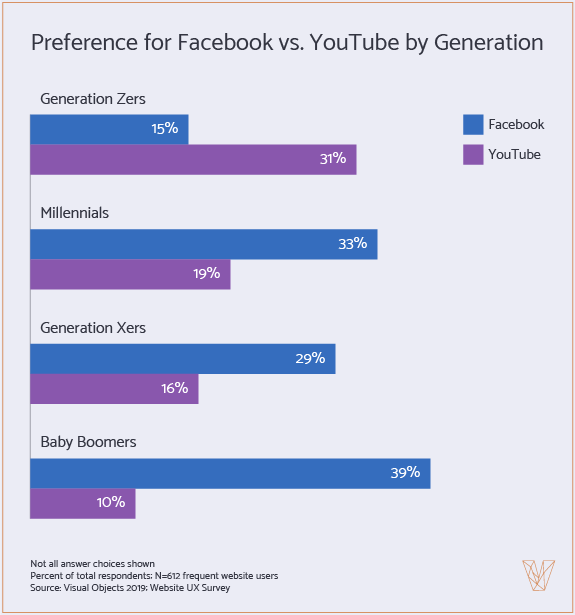
YouTube is a one-stop hub of entertainment and lifestyle options for Generation Z. As the world’s second largest search engine, YouTube allows direct and continuous access to content that can fill a variety of needs.
For Generation Z, YouTube can be a:
- TV player
- Music player
- Influencer channel
- Learning channel
Raised on digital media, Generation Z seeks an immersive web experience that revolves around open exploration, visual creativity, and rewarding interactions.
Considered “the coolest website,” YouTube provides both individual satisfaction and social cohesion for youth. According to Google, 70% of Generation Zers say that watching videos with others helps them feel more connected.
Young users like to select their personalized content on YouTube, instead of being presented with content in a feed, like on Facebook.
More than idle entertainment, though, YouTube is the top-ranked learning method for younger generations. More than half (59%) of Generation Z and 55% of millennials say YouTube is their favorite way to learn, according to the education resource company Pearson. Research by Google confirms that 80% of Generation Z reports that YouTube has helped them become more knowledgeable.
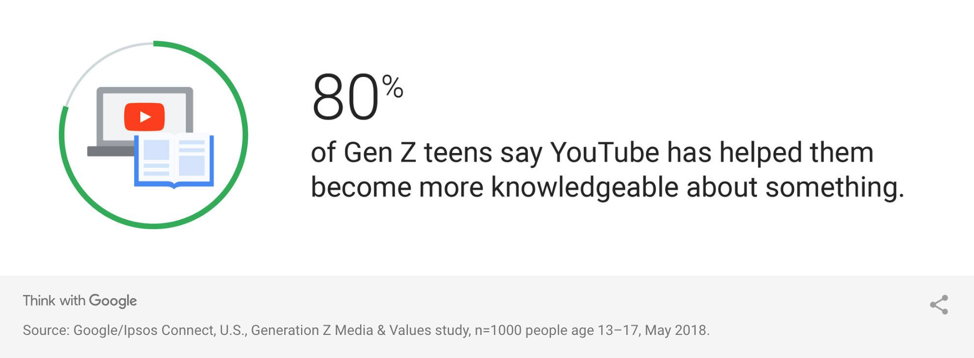
While older generations often turn to Google to answer questions, YouTube is more appealing for users who prefer visual content.
Video Provides an Intuitive Content Experience for Generation Z
As digital natives, Generation Z finds the visual interface of YouTube appealing.
YouTube content is designed for mobile, displayed prominently, and navigable with the tap of a finger. The fluid visual UX lends itself to almost effortless content consumption.
Young users are more comfortable using digital interfaces than older generations, said Jordan DeVries, director of UX at the user experience design company, Brave UX.
“There are some interesting features in the YouTube app that are particularly intuitive in terms of usability. … If you’re that age, you’ve grown up with these gestural design patterns on phones that are just inherent,” DeVries said.
Digital familiarity lets young users more actively and intuitively explore video content.
“Someone who’s older wouldn’t have grown up with those inherent, universal principles of touching and swiping,” DeVries said. That’s probably where you start to get differences between behavior. The younger struggle less.”
Young people report that they’re very confident in their ability to navigate digital interfaces, according to research firm Nielsen Norman. Young people also tend to be worse readers and thus prefer non-text alternatives.
The gestural user interface (UI) and image-based UX of YouTube suit those who don’t need direct visual cues such as blue links to navigate a website.
“We oftentimes don’t need to put as many direct visual cues for younger users,” DeVries said. “Generally, a headline with a photo and some text represents well enough that younger users will know – ‘Oh, if I click on this or I tap on this, this is going to take me where I need to go.’”
Young website users are establishing the usage standards that will predict the future of UX design, while older users try to keep pace. Web design companies can help businesses take a nuanced approach to design for different generations.
A newer video trend that attracts Generation Z is TikTok. The short and sweet video platform gained popularity at the height of the COVID-19 pandemic and shows no sign of stopping, unlike other short form video platforms.
While businesses are still advertising mainly on YouTube, companies looking to attract a younger demographic should consider how TikTok can promote their brand.
Additional Reading: ‘Social Media Video Production’
Facebook Is Declining in Popularity With Younger Generations, Increasing in Popularity With Older Generations
Younger users are less engaged with Facebook.
According to Pew Research, Facebook lost almost 20% of users ages 18-24 in the last four years. Meanwhile, older users of every age group continue to visit Facebook most frequently.
Our 2019 research showed that as age increases, the percentage of users who report that Facebook is their most-visited website increases as well. This aligns with the trend that Facebook’s user base is aging up.
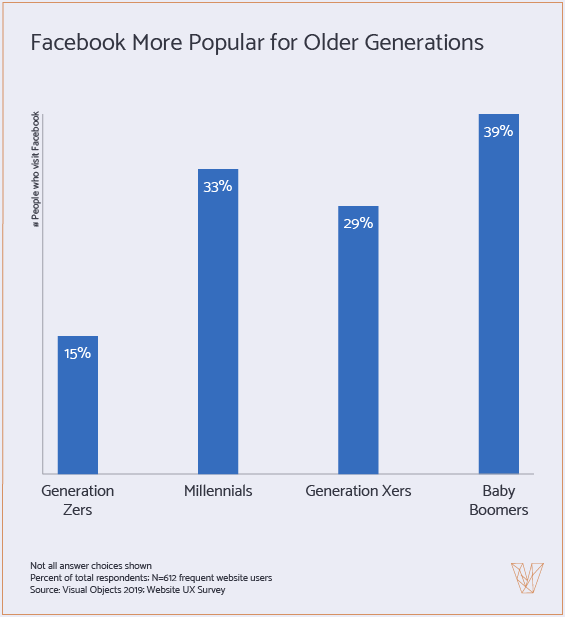
Though no stranger to video, Facebook’s UI revolves around communication. Older users appreciate the ability to keep in touch, share photos, and read the news from a single, comprehensive interface.
For many older users, Facebook was their segue into digital media. It enables them to message younger family members, and they eventually encounter other functionalities, such as photos and videos.
“With Facebook’s video and photo experience, it’s a platform [older generations] want to be on to keep up with the social lives of their kids and grandchildren,” said Richard Broughton, an analyst at the computing company Ampere.
Over 500,000 users over the age of 55 were expected to join Facebook in 2019, according to the news site The Guardian. Facebook is often the “first frontier” for many older users, but not because the UI is superior.
“I don’t think it’s because of the nature of the UI itself,” DeVries said. “I think you’ll start to see [older] people deciding to use Instagram for their vacation photos instead of Facebook.”
These older new users are a captive audience that stays on Facebook due to their unfamiliarity with or hesitance to approach other options. Yet, other platforms may begin to poach older Facebook users.
People ages 56-70 are almost three times as likely to share content on YouTube than people ages 18-34, according to Business Insider.
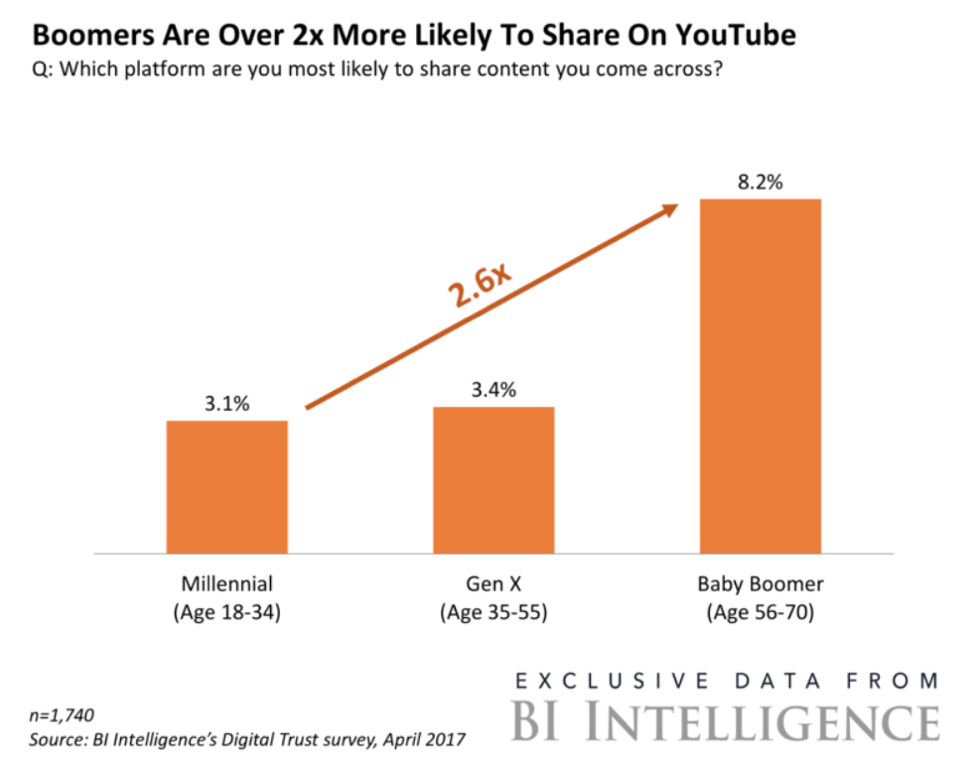
Older generations are more comfortable with digital advertising and less concerned with fake content. As this group further warms to video, businesses can expect targeted YouTube campaigns to be increasingly effective at reaching and engaging older users.
Read this: '2022 Small Business Advertising Report'
Facebook is threatened by interfaces that deliver unbroken streams of visual content, such as Snapchat and YouTube. As youth abandon Facebook, older generations will continue to embrace new websites that allow them to stay connected with young family members and peers.
Amazon Has Most Appealing UX, According to Most Generations
Website usability is subjective and varies by generation. Younger generations may be more tech-savvy, but everyone appreciates an accessible and functional website.
In 2019, we found that Amazon’s UX ranked the highest among baby boomers (29%) and Generation Xers (21%), while millennials (18%) ranked Facebook’s UX as the best. Meanwhile, Generation Z (24%) thought YouTube offered the best UX.
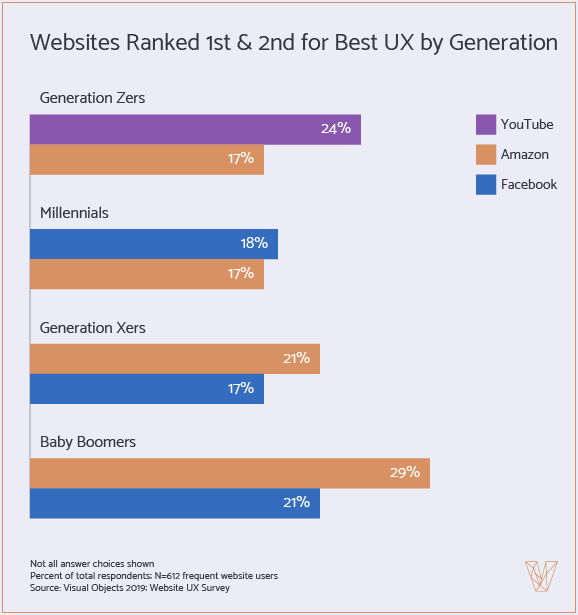
As a well-known channel for online purchases, all generations agree that Amazon is easy to use.
The example below shows the most notable factors of Amazon’s optimized UX:
- The search bar is prominent in the navigation.
- Search results are presented in an open, easy-to-read fashion.
- Filtering makes it easy to refine the search process.
- Personalization helps users find and remember what they like.
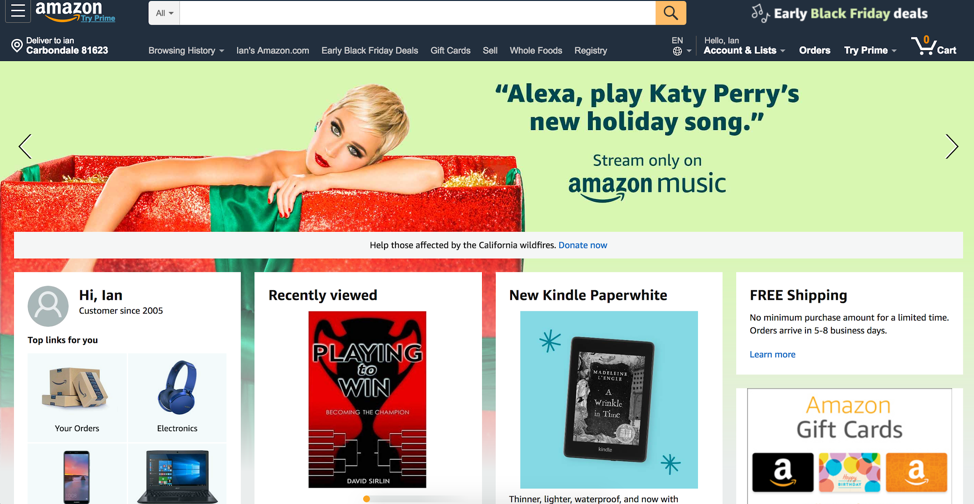
Amazon also succeeds by providing both visual cues and blue links. Rather than assume visitors know to click an image, it offers a text link for users who have yet to realize that images are interactive, as seen below.
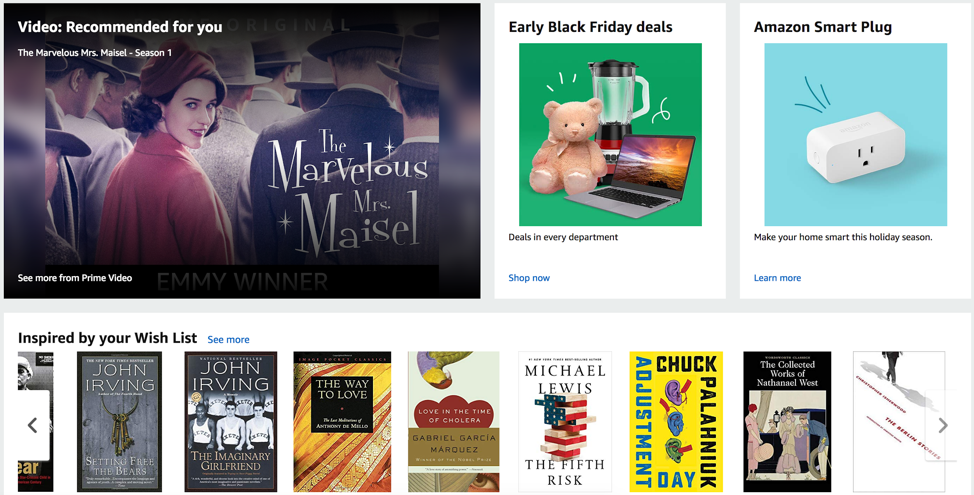
While the classic text cues are helpful, user behaviors are evolving, explained DeVries: “We’re starting to see a simplification in UI. … We don’t have to always denote a link or interactive content with an arrow or blue color.”
As older users become more familiar with online navigation, they learn to follow visual cues and need less direction.
YouTube offers a similarly accessible UX.
The layout is open, the navigation is clear, and the image-rich layout is supported by text links. The usability allows people to find, watch, and continue watching what they like, as seen on the homepage below:
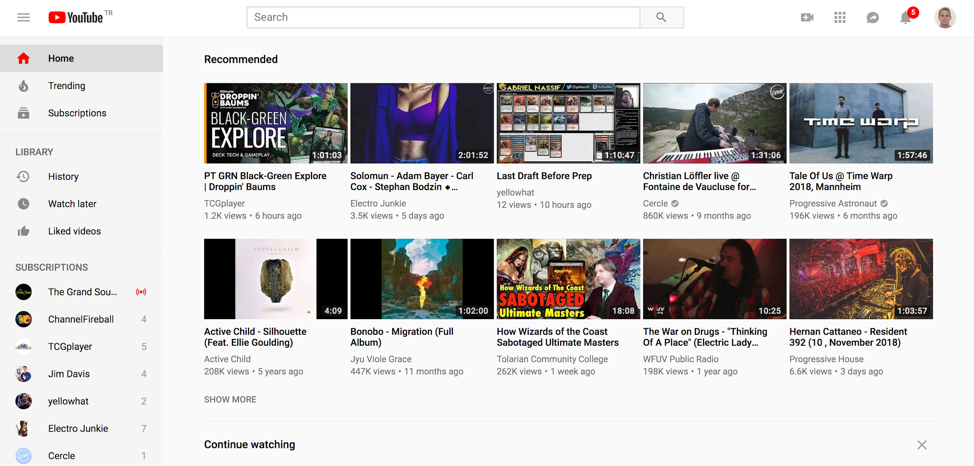
Both YouTube and Amazon use recommendation algorithms to showcase similar content or “what’s next.” As search-driven channels, the visibility of similar web content makes the site experience more rewarding for users.
Being able to see and select the next step helps streamline the UX and reduce frustration. This encourages longer site visits and leads to increased user familiarity and loyalty.
By comparison, content on Facebook’s News Feed only can be accessed by scrolling through other content. This diminishes the site experience for users looking for something specific, especially when they are regularly interrupted by advertising.
YouTube also serves ads but only after the user has selected their content. The audience is captive yet invested and therefore more willing to wait. Facebook users must wade through native ads that can redouble frustrations for people in search of authentic and relevant content.
To best engage website visitors, businesses must accommodate their target audience’s visual preferences while offering a predictive, valuable content experience.
Site Unreliability, Pop-Up Ads Are Most Frustrating Website Features
People want a website that functions as expected and doesn’t waste their time. Priorities and expectations for websites vary by generation, though.
Our 2019 data showed that most generations rank unreliability as their top frustration with websites, except Generation Z, which were most frustrated by pop-up forms. Slow page load time was the second-most frustrating website aspect for all generations.
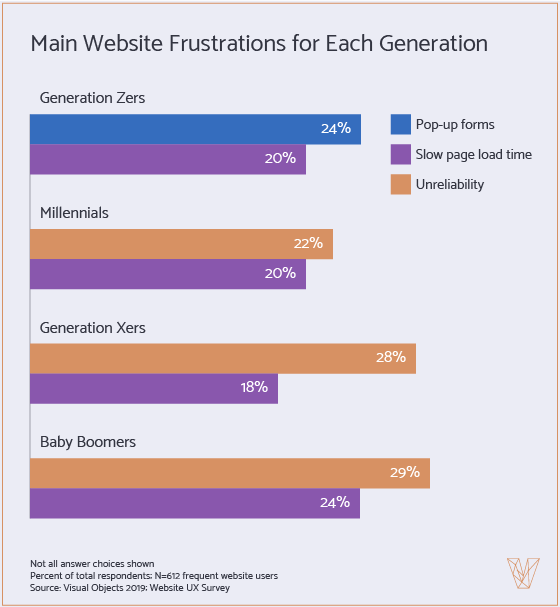
The reliability of a website becomes a greater factor with age. Older users are more inclined to blame themselves when something goes wrong with a site, while young people are more inclined to fault the site, reports research firm Nielsen Norman.
A website’s perceived reliability is based on both practical UX elements and a user’s perception.
In terms of UX, the expected functions of a website include:
- Fast page load time, ideally under two seconds
- 404 redirect pages for broken links
- Mobile responsive web design for a seamless experience across devices
- Contact information or chat support to resolve issues
- Easy checkout and signup processes
Unreliable websites are a costly liability, said Tatyana Khamdamova, design director at Blue Fountain Media.
“If you have a great-looking site that doesn't work properly and users leave because some features are not functioning right, you will lose business,” Khamdamova said.
If you’re thinking of updating your site, allocate enough resources to ensure the site functions as your target demographic expects. Overly interactive sites can confuse older users, while younger users prefer a flat design and a more interactive, visual UX.
According to Nielsen Norman, young users are more confident in their ability to navigate and find alternatives to unreliable sites. Generation Z is willing to experiment with digital interfaces – even those with radically different UX design.
Generation Z’s comfort with websites has its limits, though.
Young users are most frustrated by pop-ups on websites, rather than websites’ unreliability. According to analytics firm Marchex, Generation Z surpasses even millennials as the generation with “the shortest attention span.” Ads that invade the user’s digital space, clutter the screen, and deliver little value, as pop-ups ads often do, interfere with Generation Z’s desire for unwavering digital gratification.
While older users are more tolerant of intrusive advertising, Generation Z grew up in a world of permissive content marketing. Impatient for personal content, Generation Z also expects a more relevant ad experience.
A survey by research organization YPulse found that 20% of Generation Zers say they want a mobile ad to anticipate their next great discovery. This desire for meaningful advertising runs parallel to an intolerance for impersonal website UX, such as pop-up ads.
For example, 50% of Gen Z said they wouldn’t return to a site that didn’t personalize ads to their preferences, according to the WordPress host WP Engine.
To reach and engage Gen Z, businesses must make predictive site UX the norm. A fast and flawless UX will be critical to retaining users of all ages, especially as older generations become more familiar with and demanding of websites.
Additional Reading: 'Key Search Retargeting Benefits for Small Businesses'
Age Determines Perception and Use of Top Websites
The age and digital sophistication of the user determines how they perceive and use top websites.
In 2019, every generation visited Facebook most frequently, except for Generation Z, which prefers YouTube.
Young users prioritized the visual UX of YouTube because it provides the most engaging, linear, and rewarding content experience. Older users were less engaged with video, less demanding of digital interactions, and value the broader functionality of Facebook.
Generations varied in how they rank the best website UX, but Amazon was either the top choice or ranked second by almost every generation. Facebook was ranked highest with millennials, while Generation Z again chose YouTube.
Website unreliability was the biggest pain point for every age demographic outside of Generation Z, which is most frustrated by pop-up ads. Young users are impatient with digital interfaces and expect websites to be aligned with their preference. Slow page load times frustrated all generations.
Looking to optimize your website's experience? Check out our directory of vetted web designers.
About the Survey
In 2019, Visual Objects surveyed 612 people from the U.S. who visit at least five websites a day. Sixty-three percent (63%) are female, and 37% are male.
Survey respondents varied in age: 17% of respondents were between 18-24; 24% were 25-34; 22% were 35-44; 14% were 45-54, and 10% were 65 and over.
Respondents were from the Midwest (23%), Northeast (15%), South (41%), and West (19%).